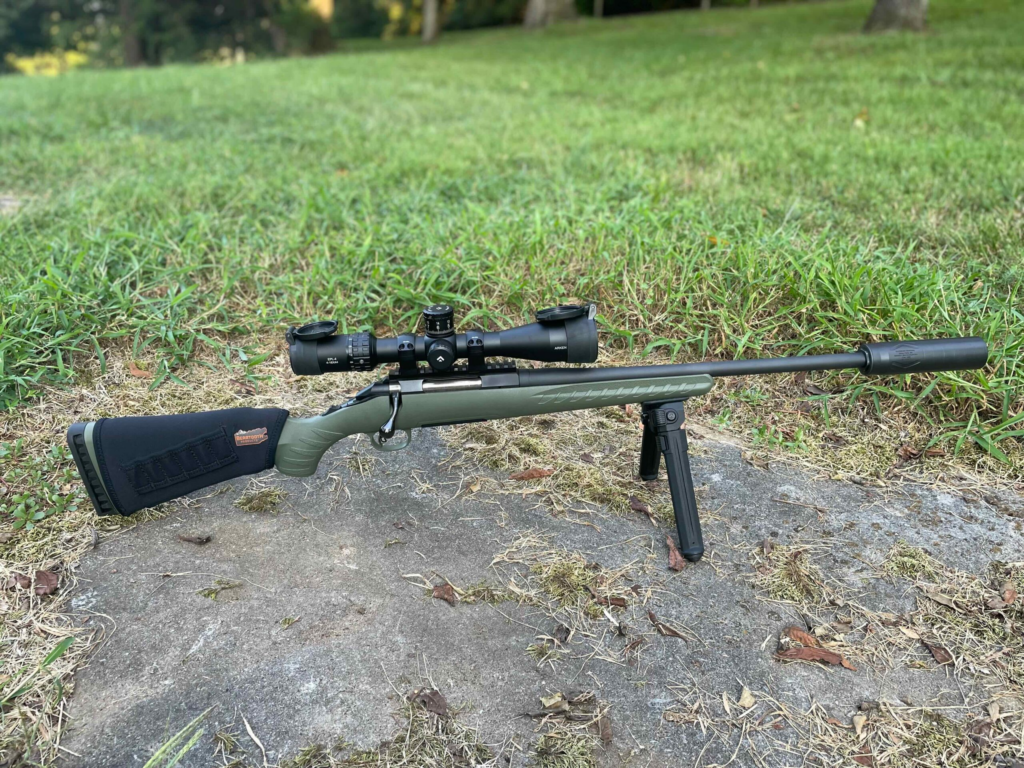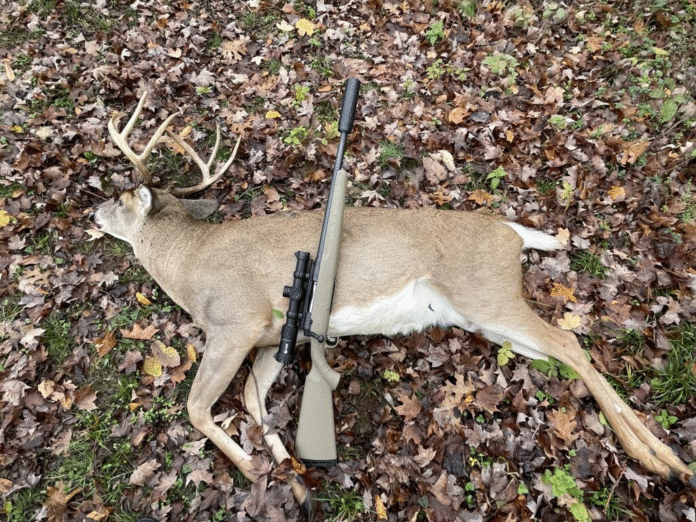The first time I pulled the trigger on a suppressed hunting rifle, I knew there was no going back.
Standing in the November chill of a Tennessee oak ridge, tracking the movement of a mature 9-point buck, I squeezed off a perfectly placed shot with my Ruger .308 Predator topped with a .30 caliber suppressor.
The report was still substantial—forget what you’ve seen in the movies—but the difference was transformative. No ear-ringing aftermath. No violent muzzle blast or recoil. Just a focused, controlled shot that dropped the buck cleanly at 150 yards.
That moment five years and dozens of suppressed hunts ago marked the beginning of my journey into what I now consider essential hunting equipment.
The Technical Side: What’s Actually Happening When You Shoot Suppressed
Let’s cut through the liberal hype and Hollywood nonsense. Modern hunting suppressors don’t “silence” anything—they’re pressure management systems that moderate the escape of superheated gases.
Most hunting suppressors reduce a .308 bolt gun’s typical 168dB bark to around 136dB. That’s still roughly the volume of a jackhammer, but the character of the sound changes dramatically.
The construction of this particular model uses a series of internal baffles machined from titanium that create expansion chambers for those gases to cool and slow down before exiting.
At only 6.16 inches long and adding 7.3 ounces to my rifle, the weight penalty is noticeable but manageable. The thread pattern (5/8×24 for most hunting calibers) creates a secure lockup that I’ve found maintains zero remarkably well, even after removing and reattaching between hunts. It also features an integrated brake, further reducing recoil and improving accuracy, making it one of the most ideal options for a hunting suppressor.
“But doesn’t it affect your bullet trajectory?” That’s the first question I get from hunting buddies. The answer is both yes and no. Yes, there is a slight shift in point of impact when you first mount a suppressor—typically 1-3 MOA in my experience across different rifles. But once you’ve zeroed your rifle with the suppressor attached, that zero remains consistent. The days of significant accuracy penalties are long gone with modern manufacturing.
Field Performance: When Theory Meets Woods
During a November whitetail hunt in Tennessee last season, the practical benefits of suppressed hunting revealed themselves in ways no spec sheet could convey. Positioned along a secluded oak ridge at first light, I spotted a mature 8-point buck trailing a doe at about 120 yards.
With an unsuppressed rifle, the shot would have echoed across the valley, likely pushing out every deer within earshot. Instead, my suppressed 300 Blackout made a moderate report that barely disturbed the nearby woods.
The buck dropped cleanly, and here’s the kicker—twenty minutes later, while still seated in my stand and making a few calls to friends about the harvest, another respectable 6-point cruised down the same trail, clearly rutting and oblivious to the earlier shot. My hunting partner in the adjacent stand was able to take him with an equally clean shot.
Two mature bucks, one location, twenty minutes apart. That simply doesn’t happen with unsuppressed rifles in my experience—I’ve spent enough opening days watching entire properties go dead silent after the first shot rings out.

The accuracy advantage isn’t just marketing speak either. The reduced anticipation of recoil and blast has measurably improved my shooting. Before switching to suppressed hunting, my typical groups at 100 yards hovered around 1.25 MOA with my favorite hunting load.
After the switch and some adjustment time, those same loads consistently produce 0.8 MOA groups. When you’re talking about shot placement on vital zones at extended ranges, that improvement translates directly to cleaner kills.
The Physiological Reality: What Science Says vs. What I’ve Experienced
The research on noise-induced flinching is fascinating, but nothing drives it home like watching it happen in real time. During a recent range outing, I let a newer hunter in our group shoot my suppressed rifle to compare with his conventional setup.
The difference in our shooting experiences was stark. Each time he touched off a round with the unsuppressed rifle, the unmistakable tension and anticipatory flinch affected his follow-through. Then, using the suppressed rifle, he maintained consistent form through each shot due to the reduced recoil and lack of concussive sound.

My chronograph tells another part of the story as well. With identical loads fired through my .308 hunting rifle, the suppressor actually increases the measured muzzle velocity by an average of 26 fps due to the slight pressure changes within the barrel.
This minimal but measurable difference represents the complex physics at work. The tradeoff is a slight increase in barrel temperature, which I’ve found becomes noticeable only after 4-5 shots in rapid succession—rarely an issue in traditional hunting scenarios.
Living with Suppressors: The Practical Realities
Let’s talk about the elephant in the room: the bureaucratic hoops. Getting my first suppressor required a $200 tax stamp, ATF Form 4 paperwork, fingerprints, photographs, and a waiting period that stretched to 11 months. Was it worth it? Unequivocally yes.
Subsequent purchases through the same dealer took similar time but felt less daunting with the process demystified. Now wait times as of April 2025 are just 17 days for a trust filing and 7 days for an individual filing!
Maintenance has proven simpler than expected. Modern suppressors like my titanium models need remarkably little care. After approximately 750 rounds through my oldest suppressor, I’ve cleaned it exactly twice by simply sealing one end of the can and filling the other with solvent.
Let the solvent sit overnight, then dump it. A few rounds though the can will kick out any dislodged debris and you should be good to go. Some manufacturers even recommend against frequent cleaning, as carbon buildup can actually improve performance to a point.
One of the day-to-day challenge is storage and transport. At just over 6 inches, my suppressor causes one of my longer 7mm PRC hunting rifles into something that requires a slightly longer case. Some hunters prefer to use dedicated suppressor pouches attached to their rifle case exterior. I always keep the tax stamp paperwork with me in the field (digital and physical copies) for the questions that may come from curious game wardens or fellow hunters.

Conservation Benefits I Never Expected
The most surprising benefit I’ve found has nothing to do with ballistics or hearing protection. It’s about conservation and animal stress. I read a report from a Texas ranch biologist was monitoring heart rates of captured deer as part of a larger study.
Shots fired from conventional rifles sent heart rates of deer skyrocketing for over 30 minutes afterward, even in animals more than a half-mile from the shot. The same monitoring during suppressed rifle hunting showed significantly reduced stress responses and shorter duration.
I’ve witnessed this firsthand during doe management hunts. With my suppressed rifle, I’ve harvested two antlerless deer from the same group within minutes—something nearly impossible with an unsuppressed rifle where the entire group typically bounds away after the first shot. This reduction in area-wide panic among wildlife represents a form of conservation I had never considered before experiencing it directly.
Fellow Hunters and Landowner Relations
The social aspects of suppressed hunting cannot be forgotten. I’ve hunted with permission from a farmer who initially had reservations about hunting near his cattle operation. The first season with my suppressed rifle changed his perspective completely.
No longer did his cattle stampede at the sound of opening day shots. His comment—”I didn’t even know you were hunting yesterday”—speaks volumes about the potential for improved hunter-landowner relations.
Similarly, on public land hunts, I have friends who have received grateful nods from fellow hunters who appreciate not having their mornings interrupted by tree stand rattling shots from the next ridge over that might spook every deer in the area. In increasingly crowded hunting areas, this courtesy factor alone makes suppressors worthwhile investments.
The Evolution of My Suppressor Collection
As with many gear enthusiasts, what started with one suppressor has evolved into a purpose-built collection. My lightweight .30 caliber titanium suppressor has become my backcountry staple where every ounce matters during long hikes.
My lightweight big-bore can handles everything from my .338 Lapua Magnum to my .223, making it the versatile option when hunting different properties in a single day.
For dedicated varmint control, my rimfire suppressor transforms my .22LR into a whisper-quiet tool that’s barely louder than the action cycling. This setup has become invaluable for agricultural pest control where minimizing disturbance matters.
Each suppressor represents a specific tool for specific hunting scenarios, but all share the core benefits of improved accuracy, reduced hearing damage, and minimized wildlife disturbance.
The Future of Hunting: Where We’re Headed
Having introduced dozens of fellow hunters to suppressed shooting, I’ve observed a pattern: initial skepticism followed by immediate conversion after the first field experience. The growth in suppressor ownership—more than doubling between 2016 and 2020—suggests I’m not alone in this discovery.
The most exciting development I’m watching is the integration of suppressor-ready designs directly into firearm manufacturing. Most major manufacturers now offer factory-threaded barrels as standard features rather than special-order options, including many affordable rifles.
Some innovative European designs are even building integral suppressors into the barrel itself, reducing overall length and weight while maintaining the benefits.

For new hunters considering the suppressor path, my advice is straightforward: start with a versatile, multi-caliber option that will grow with your hunting interests. The tax stamp and wait time are the same whether you buy a single-caliber or multi-caliber model, so flexibility matters. Materials like titanium offer the best strength-to-weight ratio for hunting applications, though the price premium is substantial.
The Verdict After Five Years
Has suppressed hunting changed my experience? Absolutely. Beyond the immediate benefits of hearing protection and improved accuracy, I’ve come to appreciate the subtle advantages: less disturbed wildlife, better relationships with landowners, reduced fatigue from repetitive shooting, and even the simple pleasure of being able to communicate with hunting partners without shouting after a shot.
The regulatory hurdles remain a barrier to entry, but that is diminishing with reduced wait times. The additional weight and length are real considerations for certain suppressors and hunting styles.
But for anyone serious about improving their hunting experience and conservation-minded practices, suppressors represent one of the most significant gear upgrades available to the modern hunter. The quiet revolution in hunting is here to stay, and my gear closet—and hunting practices—will never be the same.
Read the full article here


